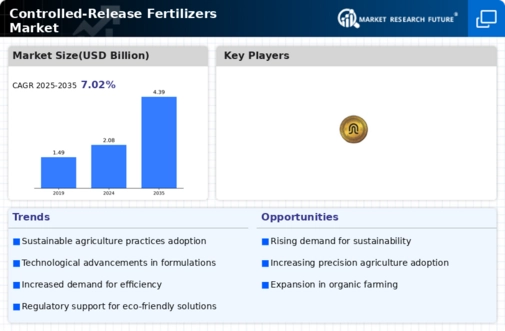Top Industry Leaders in the Controlled Release Fertilizers
 Controlled-release fertilizers Market Outlook
Controlled-release fertilizers Market Outlook
Controlled-release fertilizers (CRFs) are more than just slow-acting plant food; they represent a dynamic market brimming with innovation, fierce competition, and a growing commitment to sustainable agriculture. With billions of dollars at stake, a diverse cast of players are vying for dominance, utilizing smart strategies, navigating market dynamics, and sowing the seeds for a greener future. Buckle up, because the CRF battlefield is fertile ground for strategic maneuvers and game-changing advancements.
Innovative players.
- Agrium Inc
- Agro Bridge
- Green feed
- Agrium
- Haifa Chemicals Ltd
- Company
- Shikefeng Chemical Industry
Market Share: A Multifaceted Maze: Analysing market share in the CRF arena requires a discerning eye. Factors like geographical variations in soil types, crop types, and government regulations, coupled with the rise of customized formulations and niche player successes, necessitate a nuanced approach. Additionally, the evolving environmental landscape, with emphasis on reducing fertilizer pollution and nutrient runoff, influences market dynamics and creates opportunities for innovative players.
New Shoots Break Ground: Emerging companies like Envera Fertilizers and Locus Agricultural Solutions are adding fresh perspectives to the competition. Envera's polymer-coated CRF technology offers precise nutrient release profiles, while Locus leverages data-driven platforms to optimize CRF application rates and timing. These newcomers, though early in the game, demonstrate the potential for disruptive technologies to reshape the industry and address the growing demand for precision agriculture solutions.
Headlines in the Bloom: The CRF saga is peppered with fascinating news. Recent buzz includes the development of CRFs incorporating biochar and other organic materials, addressing both the need for nutrient efficiency and sustainable practices. Additionally, major players like Yara are investing in partnerships with ag-tech startups and expanding their digital offerings, embracing the potential of data-driven agriculture to revolutionize CRF use.
Investing in a Greener Harvest: Sustainability is becoming the new fertilizer motto. Companies are pouring resources into R&D of eco-friendly CRFs, exploring biodegradable polymer coatings, and experimenting with natural, slow-release nutrients like humic acids. This trend presents both challenges and opportunities for established players, requiring adaptation and strategic investments in green solutions.
The CRF Conundrum: The overall competitive scenario in the controlled-release fertilizer market is a vibrant ecosystem of established giants, agile challengers, and innovative newcomers. Navigating the dynamic market, catering to regional specificities, and embracing green solutions will determine the future winners and losers. Players who adapt to changing demands, invest in technological advancements, and prioritize sustainability will flourish in this fertile ground for growth and innovation.
Recent Development News :
London, January 15, 2024: The controlled-release fertilizer (CRF) market, once a niche haven, is blossoming into a mainstream force in the agricultural world. After a period of price volatility, the market seems to be finding its footing, while innovation and sustainability take centre stage, painting a vibrant picture for the future.
Price Stabilization: A Sigh of Relief: After a rollercoaster ride in 2023, CRF prices appear to be stabilizing. Analysts at CRU Group attribute this to a combination of factors, including increased production capacity from key players like Yara International and ICL Fertilizers, along with a decrease in global fertilizer demand due to economic uncertainties. This welcome news brings relief to farmers, who were struggling with high input costs in the previous year.
Bangalore, January 15, 2024: The controlled-release fertilizer (CRF) market is blossoming, fueled by a confluence of rising demand, innovative solutions, and a shift towards data-driven agriculture. While traditional giants wrestle for market share, bio-based alternatives and precision farming technologies are taking root, promising a greener and more efficient future for crop nutrition.









